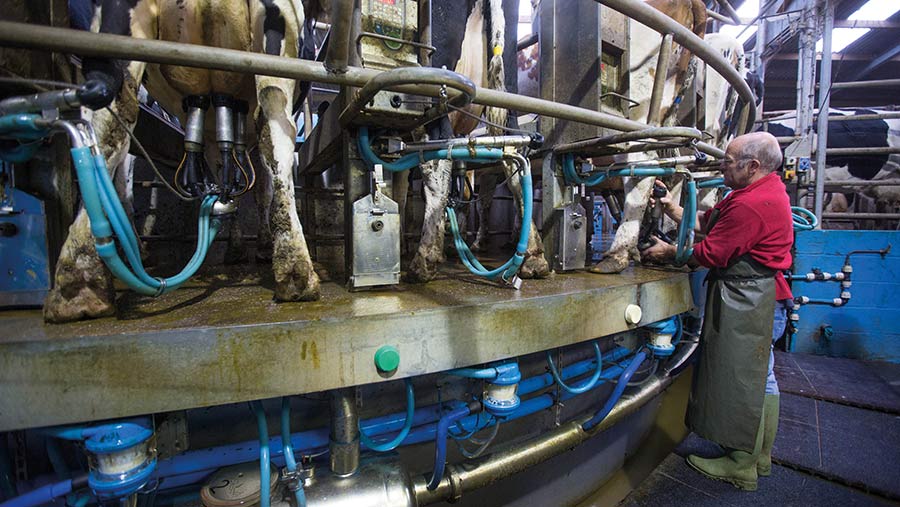Dynamic parlour testing shown to improve udder health
 © Tim Scrivener
© Tim Scrivener Using dynamic testing in milking parlours to resolve overmilking and poor milk flow issues can improve udder health, a study has revealed.
The study was carried out by Farming Connect on four dairy farms across Wales.
While an annual statutory static test is compulsory, dynamic testing is only used by about 5% of dairy farms, says vet Sotirios Karvountzis, who led the project.
A dynamic parlour test is a way of assessing the parlour during milking. It identifies ways to make the process more efficient.
See also: 5 ways to build on improvements in udder health
During the test, vacuum trace recorders produce graphs that allow the health of the milk plant to be assessed. Checks include udder preparation for good milk flow, milk liner fit, milk flow away from the teat-end and overmilking.
This means it can act as an early warning system to identify stress factors that, if left unchecked, encourage full-scale udder health issues.
The 12-month project, funded by the European Innovation Partnership in Wales, involved bimonthly visits to each farm to carry out a dynamic test, teat score and teat measure.
Multiple issues were identified during testing and interventions were introduced on the farms to improve milking plant operations and milking routines.
The result was a positive change in udder health, says Dr Karvountzis, of Mendip Vets.
“There was strong evidence across the trial farms that for every package of interventions applied in the herd, the average bulk tank somatic cell counts reduced by 3.86 x 1,000/ml,” he says.
Overmilking
The annual static test each milking parlour must undergo does not include a health check of the automatic cluster removal (ACR) function. Yet, the main contributing factor in the malfunction of an ACR is the lack of testing in those devices, says Dr Karvountzis.
Testing ACRs, which are designed to cut the vacuum off and pull the milk units from the teats when the cow finishes milking, will pinpoint discrepancies.
This could reveal that the vacuum is continuing to be applied after the cow has finished milking.
In the study, interventions under the dynamic test included checking the ACR diaphragm and the ACR cut-off milk flow.
As a result of these extra checks, the incidence of overmilking in the herds reduced by 21%.
“It is a common misconception that automation comes with greater efficiency,” says Dr Karvountzis. “The project identified that a number of ACRs were not functioning properly, resulting in overmilking of the quarter.”
Continued suction can damage the teat-end if the clusters remain on the teats for too long after milking has finished.
“Inappropriate milk plant vacuum levels and poor ability to flow milk away from the teat will have a damaging effect on the cow’s udder,” he says.
“Damaging the teat-end compromises one of the most important defences of the mammary gland against infection, with serious economic and welfare consequences,” he adds.
This damage can vary from the teat forming a hyperkeratosis – thickening of the skin – to mastitis and chronic high cell counts.
Should ACR testing become obligatory, malfunction of the ACR should be identified more regularly and such improvement in ACR performance should translate into better udder health, suggests Dr Karvountzis.
Milk flow from the teat
The study also showed that interventions advised following dynamic testing reduced the incidence of poor milk flow away from the teat by 42%.
These interventions included removing constrictions to the milk pipes relating to backflush. This was particularly important in high milk line parlours during periods of high milk yields to improve milk flow away from the teat.
Other changes involved removing long milk pipe constrictions or increasing the vacuum reserve.
Pulsation
The frequency of inadequate milk plant pulsation reduced by 48% with interventions such as checking and remedying individual pulsator malfunction.
Over time, pulsators and pulsation tubes become contaminated with dust and slime, reducing their effectiveness in transporting vacuum in the various parts of the milk plant, says Dr Karvountzis.
The project found that once the pulsators and pulsation pipes were cleaned or replaced, there were noticeable improvements at the next dynamic test.
“This raises an important point about when these parts of the milk machine should be regularly checked to detect early any deterioration of their performance,” he says.
“The obligatory annual static test of the milk plant is the obvious area that may be proposed here, but in my experience these checks are not always carried out,” he concludes.
Milk liner fit
Using the correct cluster liners for the size of teat is essential to prevent excessive air leakage. But this is difficult to achieve with some breeds.
Trying to find the right liner fit for herds with a wide range of teat sizes is also difficult, admits Dr Karvountzis.
